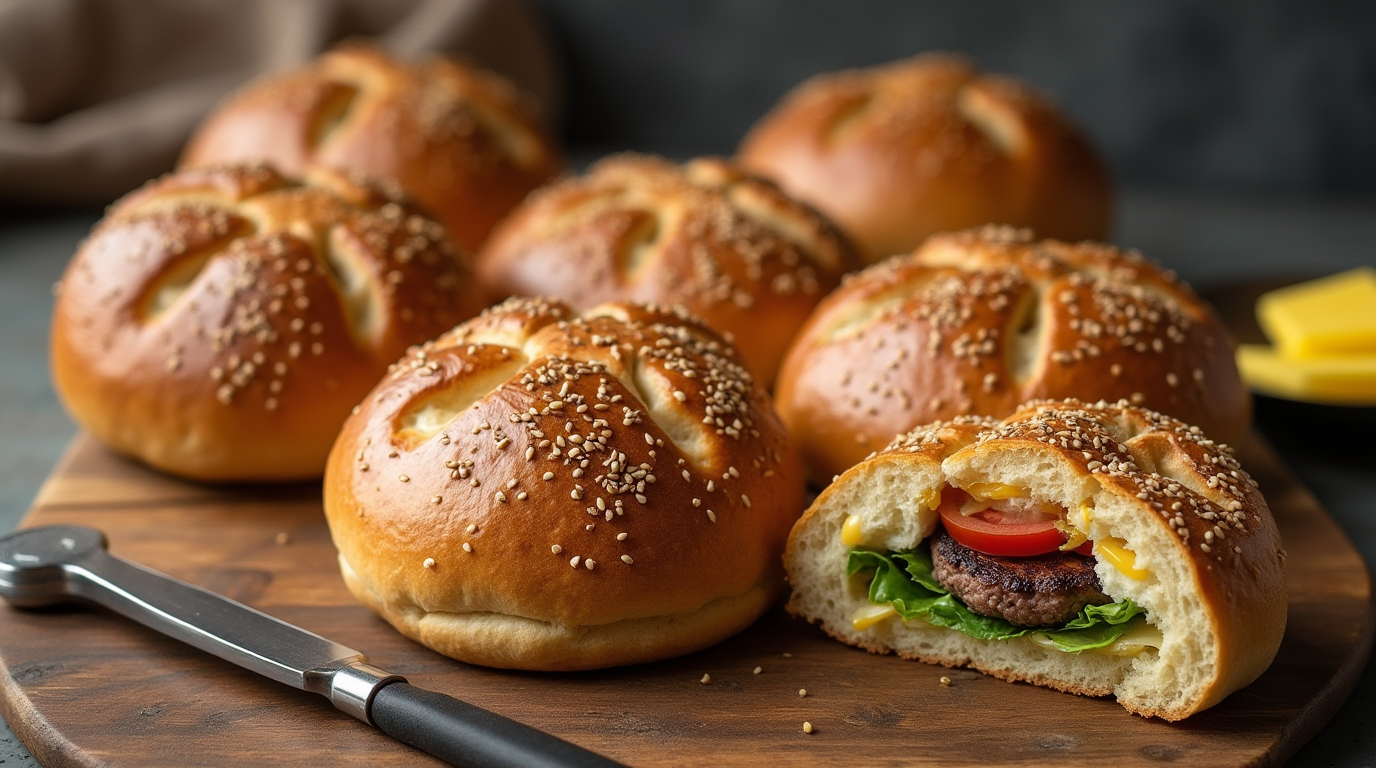When it comes to making the perfect burger or sandwich, the choice of bread is just as important as the fillings. A great bun should be sturdy enough to hold all the ingredients without getting soggy, yet soft enough to provide a satisfying bite. This is where kaiser bread shines.
Originating from Austria, kaiser rolls—also known as Vienna rolls—have become a staple in delis, bakeries, and burger joints worldwide. Their signature crusty exterior and soft, airy interior make them an ideal choice for burgers and sandwiches. Unlike standard burger buns, kaiser bread offers a slightly chewy texture, adding to the overall eating experience.
In this post, we’ll explore why kaiser bread is the ultimate choice for burgers and sandwiches, how it compares to other types of rolls, and the best ways to use it in your meals. Whether you’re a home cook or a food enthusiast, you’ll discover why this classic bread should always be in your kitchen.
What Makes Kaiser Bread Ideal for Burgers & Sandwiches?
Kaiser bread stands out as one of the best choices for burgers and sandwiches due to its unique combination of texture, size, and flavor. Unlike standard white buns or soft sandwich bread, kaiser rolls provide the perfect balance between sturdiness and softness, ensuring an enjoyable eating experience. Here’s why kaiser bread is the ideal companion for your favorite burger and sandwich creations.

Texture & Structure
One of the key reasons kaiser bread is so popular for burgers and sandwiches is its texture. The exterior has a slightly crisp, golden-brown crust, which provides a subtle crunch when bitten into. Inside, the bread is soft, airy, and slightly chewy, making it the perfect vessel for holding juicy burger patties and loaded sandwich fillings. Unlike overly soft buns that get soggy quickly, kaiser rolls can withstand sauces, melted cheese, and juicy toppings without falling apart.
Size & Shape
Kaiser rolls are typically round and generously sized, making them perfect for stacking multiple layers of ingredients. Whether you’re making a thick, gourmet-style burger or a deli sandwich piled high with meats, cheeses, and vegetables, kaiser bread provides enough space to hold everything together comfortably. The sturdy structure ensures that every bite remains intact, preventing messy spills and making it easier to enjoy your meal.
Flavor Profile
Kaiser bread has a mild, slightly yeasty flavor that complements a wide variety of fillings without overpowering them. Unlike sweet brioche buns or heavily seasoned bread, kaiser rolls allow the flavors of the burger patty, deli meats, or condiments to shine. Their neutral taste makes them versatile enough to pair well with everything from classic cheeseburgers and grilled chicken sandwiches to vegetarian options like portobello mushroom burgers or avocado and hummus sandwiches.
The combination of these characteristics makes kaiser bread an excellent choice for both casual and gourmet sandwiches and burgers. Its ability to maintain structure while enhancing flavors ensures a satisfying and delicious eating experience every time.
The History of Kaiser Bread & Its Connection to Sandwich Culture
Kaiser bread has a rich history that dates back to 18th-century Austria. The name “kaiser” means “emperor” in German, and the bread is believed to have been named in honor of Emperor Franz Joseph I. Bakers in Vienna created this distinctive roll, which quickly became popular due to its crisp crust and soft, airy interior. The signature star pattern on the top of the roll was traditionally hand-shaped by skilled bakers, symbolizing craftsmanship and quality.

As European immigrants moved to different parts of the world, they brought their baking traditions with them. In the United States, kaiser rolls became a bakery staple, particularly in cities with large immigrant communities such as New York and Chicago. Over time, these rolls evolved to suit local tastes, with variations including seeded and plain versions. Some recipes incorporated eggs and milk for a softer texture, while others maintained the traditional water-based dough for a chewier bite.
The connection between kaiser bread and sandwiches grew as delis and diners across the country adopted it as their bread of choice. Its sturdy structure made it ideal for holding thick deli meats, cheeses, and toppings without becoming soggy. Classic sandwiches such as the pastrami on kaiser roll, turkey club, and roast beef sandwich became iconic in American cuisine. Additionally, kaiser rolls became a favorite for hamburgers, providing a flavorful alternative to standard burger buns.
Today, kaiser bread remains a beloved choice for sandwiches and burgers. It is widely available in bakeries, supermarkets, and restaurants, and many home bakers have started making their own versions. Whether enjoyed with traditional deli meats, gourmet burger patties, or even as a breakfast sandwich, kaiser bread continues to play an essential role in sandwich culture worldwide.
The Best Ways to Use Kaiser Bread for Delicious Meals
Kaiser bread is a versatile option that enhances the taste and texture of many meals. Whether you’re making a hearty burger, a stacked deli sandwich, or experimenting with new recipes, this classic roll provides the perfect base. Its firm crust helps hold ingredients together, while the soft interior ensures every bite is enjoyable. Here are some of the best ways to use kaiser bread in your meals.

Perfect for Burgers
One of the most popular uses for kaiser bread is as a burger bun. Unlike traditional burger buns, which can become soggy from sauces and juices, kaiser rolls offer a sturdier structure. This makes them ideal for holding thick burger patties along with toppings like lettuce, tomatoes, cheese, and condiments. The slight chewiness of the roll adds an extra layer of texture that enhances the overall burger experience. Some people even toast the roll slightly to add a crisp layer that helps lock in flavors.
Great for Deli Sandwiches
Kaiser bread is also a favorite for deli-style sandwiches. Its round shape and fluffy interior make it perfect for stacking layers of meats, cheeses, and vegetables. Whether you prefer pastrami, turkey, ham, or roast beef, this bread holds up well to both cold and hot sandwich fillings. Unlike softer sandwich bread that can easily become compressed, kaiser bread maintains its shape, keeping each bite satisfying. Adding a spread like mustard, mayonnaise, or pesto complements the natural flavor of the bread while enhancing the sandwich’s overall taste.
Other Creative Uses
Beyond burgers and deli sandwiches, kaiser bread can be used in many other delicious ways. It makes an excellent base for breakfast sandwiches when paired with eggs, bacon, and cheese. It can also be sliced and turned into garlic bread, brushed with butter and herbs, and toasted to perfection. Some people even use day-old kaiser rolls for making homemade croutons, stuffing, or bread pudding. The versatility of this bread makes it a great addition to any kitchen, providing endless possibilities for creative meals.
Kaiser bread is more than just a basic roll. Its texture, flavor, and ability to hold up in various dishes make it an excellent choice for burgers, sandwiches, and beyond. Whether you are making a classic meal or trying something new, kaiser bread is a reliable and delicious option.
How to Choose or Make the Best Kaiser Bread
Kaiser bread is widely available in bakeries and grocery stores, but not all rolls are made the same. Choosing the right one or making it from scratch can significantly enhance the quality of your burgers and sandwiches. Understanding what makes a great kaiser roll will help you find or bake the perfect bread for any meal.

Buying Tips for Store-Bought Kaiser Rolls
When purchasing kaiser rolls from a store or bakery, there are a few key factors to consider. Look for a roll that has a slightly crispy and golden-brown crust, as this is a sign of proper baking. The inside should be soft and airy, with a slight chewiness that holds up well to fillings. Some kaiser rolls come plain, while others have a topping of poppy or sesame seeds. Choosing between them depends on your personal preference and the type of sandwich you are making.
Another important aspect is freshness. Rolls that feel too firm or dry may have been sitting on the shelf for too long. If possible, check the packaging date or ask the bakery staff when the bread was baked. Fresh kaiser rolls will always deliver the best taste and texture.
Making Homemade Kaiser Bread
Baking kaiser bread at home allows you to control the ingredients and achieve the perfect texture. The process involves a few simple steps but requires attention to detail to get the best results. The dough is typically made with flour, water, yeast, sugar, salt, and a small amount of fat, such as butter or oil, to give it a soft interior.
One of the most distinctive features of kaiser bread is its signature star pattern on top. Traditionally, this is achieved by folding the dough in a specific way, but a kaiser roll stamp can also be used to create the design. After shaping, the rolls need time to proof so that they develop a light and airy structure. Baking at the right temperature ensures that the crust forms properly while keeping the inside soft and fluffy.
For those who enjoy experimenting, different variations can be made by adding toppings like sesame seeds, poppy seeds, or even a sprinkle of coarse salt. Whole wheat or multigrain flour can also be used for a healthier version.
Storing and Maintaining Freshness
Whether store-bought or homemade, proper storage is essential to keep kaiser bread fresh. Rolls should be kept in an airtight bag or container at room temperature to prevent them from drying out. If they won’t be used within a couple of days, freezing is the best option. Wrapping the rolls in plastic wrap or placing them in a freezer-safe bag will help maintain their texture.
To revive slightly stale rolls, they can be warmed in the oven for a few minutes to restore their crispiness. If using frozen rolls, letting them thaw at room temperature or heating them slightly will bring back their freshness.
By knowing how to select, bake, and store kaiser bread, you can always have the perfect rolls ready for your favorite burgers and sandwiches.
Try out this Kaiser Bread and let your creativity shine! We’d love to see your sweet creations. Tag us on Instagram at @SweetEatsRecipes and use the hashtag #KaiserBread to get featured.
Kaiser Rolls
Equipment
- Mixing Bowl
- Measuring Cups and Spoons
- Stand mixer (optional)
- Baking sheet
- Kaiser roll stamp (optional)
- Kitchen towel
Ingredients
- 3 ½ cups all-purpose flour
- 1 cup warm water
- 2 ¼ teaspoons active dry yeast
- 2 tablespoons sugar
- 1 teaspoon salt
- 2 tablespoons butter (softened)
- 1 egg (for egg wash)
- Sesame or poppy seeds (optional)
Instructions
- Activate the yeast – In a small bowl, mix warm water, sugar, and yeast. Let it sit for 5–10 minutes until foamy.
- Make the dough – In a mixing bowl, combine flour, salt, and butter. Add the yeast mixture and knead for about 8–10 minutes until smooth.
- First rise – Cover the dough with a kitchen towel and let it rise for about an hour or until doubled in size.
- Shape the rolls – Divide the dough into equal portions and shape into balls. Use a kaiser roll stamp or fold the dough to create the traditional pattern.
- Second rise – Place the rolls on a baking sheet, cover, and let them rise for another 30 minutes.
- Bake – Brush with egg wash and sprinkle with sesame or poppy seeds if desired. Bake at 375°F (190°C) for 15–20 minutes until golden brown.
- Cool & serve – Let the rolls cool before slicing and using for burgers or sandwiches.
Notes
- For extra softness, add ¼ cup of milk to the dough.
- Store in an airtight container for up to 3 days or freeze for longer storage.
- Use whole wheat flour for a healthier alternative.


